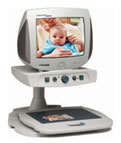For vision loss that is mild there are many easily available low tech solutions that can make daily tasks more comfortable:
 The best thing for anyone with even mild vision loss is “light”. As we get older, the pupil gets smaller, the lens inside the eye becomes yellow and less clear, and the retina can loose photoreceptive ability. It takes more watts of light to see adequately. Where a 15 year old may be fine with reading with a 40 watt light, those with more seasoning will appreciate a minimum of 60-100 watts of light directed on the page in addition to good ambient room light.
The best thing for anyone with even mild vision loss is “light”. As we get older, the pupil gets smaller, the lens inside the eye becomes yellow and less clear, and the retina can loose photoreceptive ability. It takes more watts of light to see adequately. Where a 15 year old may be fine with reading with a 40 watt light, those with more seasoning will appreciate a minimum of 60-100 watts of light directed on the page in addition to good ambient room light.- Purchase a good reading lamp for your favorite reading location.
- Glare is a common frustration. We suggest the GE Reveal light bulb which provides good light without the yellowing of standard incandescent and without the scattered glare of fluorescent lighting.
 A hand held magnifier with an integrated battery operated light that fits in a purse or pocket is a great asset at restaurants and on the go. We carry a selection of optical quality magnifiers in both pocket and stand designs
A hand held magnifier with an integrated battery operated light that fits in a purse or pocket is a great asset at restaurants and on the go. We carry a selection of optical quality magnifiers in both pocket and stand designs Desk lamp magnifier lights are a huge asset. Small print on medicine bottles, threading a needle, seeing the small print in the phone book… a myriad of small detail can be seen much more readily.
Desk lamp magnifier lights are a huge asset. Small print on medicine bottles, threading a needle, seeing the small print in the phone book… a myriad of small detail can be seen much more readily.
For vision loss that’s moderate to severe more specialized prescription optical devices and technological magnifiers and other adaptive aids can be a huge asset. The types of low vision devices available include:
- Special “high plus” magnifying glasses & microscopic lenses. These require readiness on the part of the individual to be willing to use an adaptive device that requires a moderate level of sophistication to master.
 Hand held and stand magnifiers: illuminated magnifiers are particularly beneficial and very easy to use. LED and Xenon and Halogen light sources provide better contrast than conventional incandescent lighting.
Hand held and stand magnifiers: illuminated magnifiers are particularly beneficial and very easy to use. LED and Xenon and Halogen light sources provide better contrast than conventional incandescent lighting.- Desk Lamp Magnifier. Every home should have one. Prescription bottle instructions, small print on bills, crafts, telephone book print can be seen under the light plus magnifier combination.
 Telescopic devices, can be hand held or mounted to glasses for viewing distant objects. For selected types of low vision patients, spectacle mounted telescopes may be used for driving. There’s even a new headworn lightweight telescopic with 2.1x magnification called “Max TV” for viewing TV.
Telescopic devices, can be hand held or mounted to glasses for viewing distant objects. For selected types of low vision patients, spectacle mounted telescopes may be used for driving. There’s even a new headworn lightweight telescopic with 2.1x magnification called “Max TV” for viewing TV.- Special tints can improve vision, enhance contrast. Blue Light Scatter has been implicated in causing free radical damage in retinal disease such as macular degeneration. Blue block tints are strongly recommended for protection: Amber, yellow or polarized brown lenses are available to block the blue scatter frequencies.
 Electronic Video Displays and Closed Circuit TV magnification systems not only magnify, they can also enhance contrast. Although more expensive, they provide a huge range of magnification at the control of the user.
Electronic Video Displays and Closed Circuit TV magnification systems not only magnify, they can also enhance contrast. Although more expensive, they provide a huge range of magnification at the control of the user. Non Optical Devices can provide an amazing improvement to quality of life and independence for those with low vision. Simple things like thick marking pens for writing, labeling cans and jars with large print, utilizing special cutout guides for writing and signing checks and talking watches can be a real asset to independence.
Non Optical Devices can provide an amazing improvement to quality of life and independence for those with low vision. Simple things like thick marking pens for writing, labeling cans and jars with large print, utilizing special cutout guides for writing and signing checks and talking watches can be a real asset to independence.
Determining what devices will enhance an individuals’ quality of life goes well beyond the basic exam for normal glasses. When you or your loved one is ready, we look forward to working with you. It is our passion to assist each individual in protecting their precious vision and in functioning to their fullest potential.
© Copyright Phillips Eye Center






